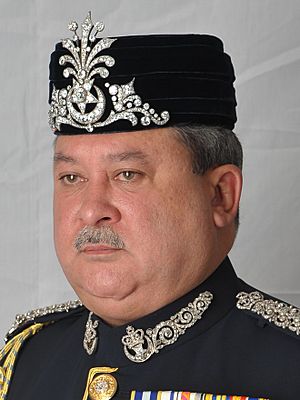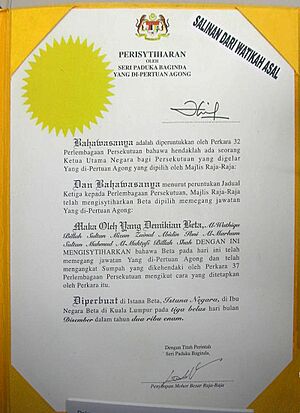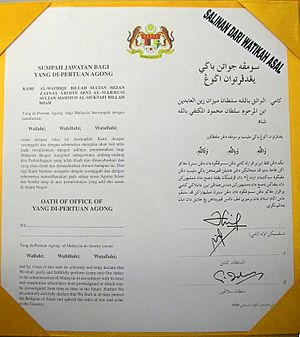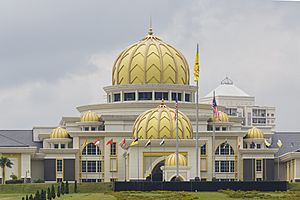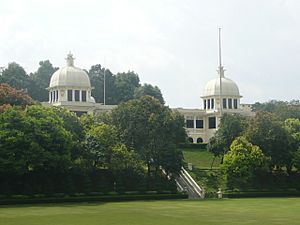Yang di-Pertuan Agong facts for kids
Quick facts for kids Supreme Head of the Federation |
|
|---|---|

Royal Standard
|
|

Royal coat of arms
|
|
| Style | His Majesty |
| Residence |
|
| Appointer | Conference of Rulers |
| Term length | Five years, non renewable immediately |
| Constituting instrument | Constitution of Malaysia, Article 32 |
| Formation | 31 August 1957 |
| First holder | Tuanku Abdul Rahman |
| Deputy | Deputy Yang di-Pertuan Agong |
| Salary | RM1,054,560 annually US$223,069.00 anually |
The Yang di-Pertuan Agong is the official King of Malaysia. This special role makes him the constitutional monarch and head of state for the whole country. The name means "He Who is Made Lord" in Malay. People also call him the Supreme Head of the Federation or simply the Agong.
This important position started in 1957. That was when Malaysia (then called the Federation of Malaya) became independent from the United Kingdom. The Yang di-Pertuan Agong is chosen by the Conference of Rulers. This group includes the nine rulers from the different Malay states. They take turns holding the position, which makes Malaysia one of the few countries in the world with an elected monarchy.
The 17th and current Yang di-Pertuan Agong is Ibrahim Iskandar of Johor. He was chosen on October 26, 2023. He officially started his role at the Istana Negara on January 31, 2024.
The Yang di-Pertuan Agong's wife is called the Raja Permaisuri Agong. Her current title is Raja Zarith Sofiah. In English, the King is called "His Majesty" and the Queen is called "Her Majesty".
Contents
The King's Role in Malaysia
The Yang di-Pertuan Agong acts as a constitutional monarch. This means he follows the rules set out in the Federal Constitution of Malaysia. These rules explain his powers as the head of state. His powers fall into two main groups:
- Powers he uses based on advice from the government (like the Cabinet).
- Powers he can use on his own (discretionary powers).
The Constitution gives the King the power to run the federal government. However, he usually uses this power based on the advice of the Cabinet. So, the Cabinet does most of the daily work of governing the country.
What the King Can Decide On His Own
The Yang di-Pertuan Agong has a few special powers he can use without advice. These include:
- Choosing the Prime Minister.
- Saying no to dissolving Parliament.
- Calling meetings with the Conference of Rulers to discuss royal matters.
The King is expected to choose a Prime Minister who has the support of most members in the Dewan Rakyat. This is the elected lower house of Parliament. If a Prime Minister loses support, the King might need to choose a new one or call for an election.
The King can choose the Prime Minister if no political party wins a clear majority. He can also refuse a request to dissolve Parliament. He can end or dissolve Parliament, but only if the Prime Minister asks him to. He can also reject new laws or changes to old laws. However, if he keeps refusing, the law will automatically pass after 30 days.
Important Appointments by the King
The Yang di-Pertuan Agong appoints many important people in Malaysia. These appointments follow rules in the Constitution and other laws.
Government Leaders
- The Prime Minister: Chosen from elected members of the House of Representatives. The King picks someone he believes has the support of most members. This is usually the leader of the winning party.
- Deputy Prime Minister, Ministers, and Deputy Ministers: Appointed based on the Prime Minister's advice.
- Chief Secretary to the Government: Appointed based on the Prime Minister's advice.
Commissions and Committees
- The Election Commission: Appointed with advice from the Conference of Rulers.
- The Judicial and Legal Service Commission: Appointed after talking with the Chief Justice.
- The Malaysian Public Service Commission: Appointed after considering the Prime Minister's advice and talking with the Conference of Rulers.
Judges
- The Chief Justice of Malaysia: Appointed with advice from the Prime Minister and the Conference of Rulers.
- The Chief Judge of Malaya: Appointed with advice from the Prime Minister and the Conference of Rulers.
- The Chief Judge of Sabah and Sarawak: Appointed with advice from the Prime Minister and the Conference of Rulers.
Senators
The Yang di-Pertuan Agong appoints 44 senators to the Dewan Negara. This is the upper house of Parliament.
State Governors
The King appoints the Yang di-Pertua Negeri (Governors) for the states of Penang, Malacca, Sabah, and Sarawak. He does this after considering the advice of each state's Chief Minister. He also appoints the Mayor and City Council of Kuala Lumpur.
Head of Islam
The Yang di-Pertuan Agong is also the Head of Islam in four states that have appointed Governors. These are Penang, Malacca, Sabah, and Sarawak. He is also the Head of Islam in the three Federal Territories and in his own home state. He gets advice from the State Islamic Affairs Council in each of these places.
The King appoints the leaders and members of these councils. He also appoints the State Mufti (religious leader) in these states. There is one Islamic Affairs Council for the three Federal Territories, also appointed by the King.
Commander-in-Chief of the Armed Forces
The Yang di-Pertuan Agong is the Commander-in-Chief of the Malaysian Armed Forces. This means he is the highest-ranking officer in the military.
As the Supreme Commander, the King appoints the Chief of Defence Forces. He does this based on the advice of the Armed Forces Council. He also appoints the leaders of the Army, Navy, and Air Force.
History of the King's Role
On August 31, 1957, the Conference of Rulers chose the first King. They decided on the title Yang di-Pertuan Agong. The oldest ruler, Sultan Ibrahim of Johor, was first in line but declined due to his age. The next in line, Sultan Abu Bakar of Pahang, was not chosen by the other rulers. Finally, Abdul Rahman of Negeri Sembilan was elected by most votes.
Here are the rulers who attended the first Conference of Rulers after Malaysia was formed:
| Title | State Rulers |
|---|---|
| Tuanku Abdul Rahman ibni Almarhum Tuanku Muhammad | |
| Sultan Hisamuddin Alam Shah Al-Haj ibni Almarhum Sultan Alauddin Sulaiman Shah | |
| Tuanku Syed Putra ibni Almarhum Syed Hassan Jamalullail | |
| Sultan Ismail Nasiruddin Shah ibni Almarhum Sultan Zainal Abidin III | |
| Sultan Badlishah ibni Almarhum Sultan Abdul Hamid Halim Shah | |
| Sultan Ibrahim ibni Almarhum Sultan Muhammad IV | |
| Sultan Abu Bakar Riayatuddin Al-Muazzam Shah ibni Almarhum Sultan Abdullah Al-Mutassim Billah Shah | |
| Tunku Ismail ibni Sultan Ibrahim | |
| Sultan Yussuff Izzuddin Shah Ibni Almarhum Sultan Abdul Jalil Karamatullah Nasiruddin Mukhataram Shah Radziallah Hu'an-hu |
How the King is Elected
The Yang di-Pertuan Agong is chosen for a five-year term. He is elected by the nine rulers of the Malay states. These rulers form the Conference of Rulers. Once a ruler has been the Yang di-Pertuan Agong, he cannot be chosen again until all the other state rulers have had their turn.
If the position becomes empty (due to death, resignation, or removal), the Conference of Rulers elects a new King. The new King also serves a full five-year term. After his term, the Conference holds a new election, and he cannot be re-elected right away.
The position usually rotates among the nine rulers in a set order. This order was first based on how long each ruler had been in power in 1957. The Conference of Rulers can change this order if needed. Rulers who are too young cannot be chosen.
The Conference of Rulers meets regularly. The four governors of states without hereditary rulers also attend. However, only the rulers can vote and be chosen as King.
Who Can Be Elected King?
- Only a ruler can be elected.
- Only the rulers can vote.
A ruler cannot be elected as Yang di-Pertuan Agong if:
- They are too young.
- They say they do not want to be elected.
- The Conference of Rulers decides they are not suitable due to health reasons or other causes. At least five members must agree to this decision.
The Election Process
The election uses a secret ballot. The ballot papers are not numbered and are put into a ballot box. Only the rulers take part in the election. A ruler can appoint another ruler to vote for them if they cannot attend.
During the election, the Keeper of the Rulers' Seal gives out ballots with one candidate's name. Each ruler says if the candidate is suitable or not. The youngest ruler (who is not a candidate) or the outgoing King counts the votes with the Keeper of the Rulers' Seal.
A candidate needs at least five votes to be offered the position. If the candidate refuses or does not get enough votes, the process repeats with the next ruler in line. The election is only finished when a ruler accepts the role. The Conference then announces the new King for a five-year term. The ballot papers are destroyed after the results are announced.
When a ruler becomes King, he appoints a regent for his home state. This regent acts as the head of state for that state during the King's five-year term. The regent is usually a close family member. The King remains the head of Islam for his state.
Order of States for Election
Since the first cycle of nine Kings (1957–1994), the order among the eligible state rulers has been:
 The Yang di-Pertuan Besar of Negeri Sembilan
The Yang di-Pertuan Besar of Negeri Sembilan The Sultan of Selangor
The Sultan of Selangor The Raja of Perlis
The Raja of Perlis The Sultan of Terengganu
The Sultan of Terengganu The Sultan of Kedah
The Sultan of Kedah The Sultan of Kelantan
The Sultan of Kelantan The Sultan of Pahang
The Sultan of Pahang The Sultan of Johor
The Sultan of Johor The Sultan of Perak
The Sultan of Perak
This order was first based on seniority. However, now rulers are chosen according to this cycle, no matter how long they have been in power. There is no fixed line of succession for the Malaysian throne.
Four Malaysian states do not have hereditary rulers: Malacca, Penang, Sarawak, and Sabah. These states, along with Malaysia's three Federal Territories, do not provide the Yang di-Pertuan Agong.
King's Residences
The official home of the Yang di-Pertuan Agong is Istana Negara (the National Palace). It is in Kuala Lumpur and was finished in 2011. It replaced the old Istana Negara, which is now The Royal Museum. Another royal home is Istana Melawati in Putrajaya. This palace is also where the Conference of Rulers holds its meetings.
Titles and How to Address the King
| Styles of The Yang di-Pertuan Agong |
|
|---|---|
| Reference style | His Majesty |
| Spoken style | Your Majesty |
| Alternative style | Tuanku |
The Yang di-Pertuan Agong's full title in Malay is Kebawah Duli Yang Maha Mulia Seri Paduka Baginda Yang di-Pertuan Agong.
- Kebawah Duli Yang Maha Mulia means 'Under the dust of the Almighty'. It shows that the King's power is small compared to God's.
- Seri Paduka Baginda refers to a person who is victorious.
- Yang di-Pertuan Agong means 'He who is made Supreme Lord'. Agong means 'supreme'.
People often call him "Paramount Ruler" or "King" in English. In formal English letters, he was called "His Majesty The Yang di-Pertuan Agong". In January 2024, this changed to "His Majesty The King of Malaysia".
When you formally address the Yang di-Pertuan Agong, you say:
- In Malay: Tuanku (meaning 'My Lord')
- In English: Your Majesty
Royal Standards
The Royal Standard of the Yang di-Pertuan Agong is a yellow flag. It has the Coat of arms of Malaysia in the middle, surrounded by a rice paddy wreath. The Queen's standard is green with the same design. The Deputy Yang di-Pertuan Agong's standard is yellow on top and light blue on the bottom. It has the coat of arms in the center.
Deputy Yang di-Pertuan Agong
The Deputy Yang di-Pertuan Agong is chosen right after the King. This role is usually given to the ruler who is next in line after the King. The Deputy King takes over if the King is away or cannot perform his duties due to illness.
The Deputy Yang di-Pertuan Agong does not automatically become King if the position becomes empty. He acts as the head of state until a new King and Deputy King are elected.
The current Deputy Yang di-Pertuan Agong is Sultan Nazrin Muizzuddin Shah. He has held this position since December 13, 2016.
Official Birthday
The first Saturday of June used to be the Yang di-Pertuan Agong's official birthday. This day was celebrated across the nation, especially in Kuala Lumpur.
The date for the official birthday has changed a few times. From 2021, the King's birthday will be on the first Monday of June.
Birthday Celebrations
The Istana Negara in Kuala Lumpur hosts the annual King's Birthday Honours List Ceremony. The King and Queen attend this event. Members of the government, Parliament, and foreign diplomats are also there. During this ceremony, national heroes and achievers receive awards and titles. The King also gives a speech to the nation, broadcast on radio and TV. Afterward, there is a traditional high tea at the palace.
Trooping the Colour
Malaysia also has a "Trooping the Colour" parade. This event is inspired by British traditions but has become a unique Malaysian celebration. It takes place on Kuala Lumpur's Independence Square. The Yang di-Pertuan Agong, as the Supreme Commander of the Malaysian Armed Forces, takes the salute. Military commanders, personnel, and veterans attend. The King wears his special No.1 dress uniform. He may also wear a colored sash representing the regiment he is Colonel-in-Chief of.
RTM broadcasts the ceremony live.
Yang di-Pertuan Agong Scholarship
In November 2006, the 10th Yang di-Pertuan Agong started a scholarship program. It gives scholarships to outstanding students to study at top universities worldwide. These scholarships are awarded at the Istana Negara during Independence Day celebrations.
Lists of Kings and Deputies
Yang di-Pertuan Agong
The following rulers have served as the Yang di-Pertuan Agong:
| # | Image | Name | State | Reign | Time in Reign | Birth | Death |
|---|---|---|---|---|---|---|---|
| 1 | 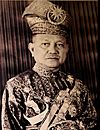 |
Tuanku Abdul Rahman | 31 August 1957 – 1 April 1960 | 2 years, 215 days | 24 August 1895 | 1 April 1960 (aged 64) | |
| 2 | 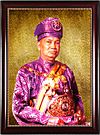 |
Sultan Hisamuddin Alam Shah | 14 April 1960 – 1 September 1960 | 141 days | 13 May 1898 | 1 September 1960 (aged 62) | |
| 3 |  |
Tuanku Syed Putra | 21 September 1960 – 20 September 1965 | 5 years, 0 days | 25 November 1920 | 16 April 2000 (aged 79) | |
| 4 | 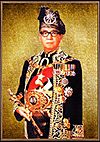 |
Sultan Ismail Nasiruddin Shah | 21 September 1965 – 20 September 1970 | 5 years, 0 days | 24 January 1907 | 20 September 1979 (aged 72) | |
| 5 | 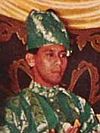 |
Sultan Abdul Halim Mu’adzam Shah 1st term |
21 September 1970 – 20 September 1975 | 5 years, 0 days | 28 November 1927 | 11 September 2017 (aged 89) | |
| 6 |  |
Sultan Yahya Petra | 21 September 1975 – 29 March 1979 | 3 years, 190 days | 10 December 1917 | 29 March 1979 (aged 61) | |
| 7 | Sultan Ahmad Shah | 26 April 1979 – 25 April 1984 | 5 years, 0 days | 24 October 1930 | 22 May 2019 (aged 88) | ||
| 8 | 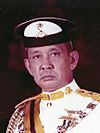 |
Sultan Iskandar | 26 April 1984 – 25 April 1989 | 5 years, 0 days | 8 April 1932 | 22 January 2010 (aged 77) | |
| 9 |  |
Sultan Azlan Muhibbuddin Shah | 26 April 1989 – 25 April 1994 | 5 years, 0 days | 19 April 1928 | 28 May 2014 (aged 86) | |
| 10 | 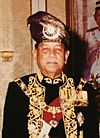 |
Tuanku Ja'afar | 26 April 1994 – 25 April 1999 | 5 years, 0 days | 19 July 1922 | 27 December 2008 (aged 86) | |
| 11 |  |
Sultan Salahuddin Abdul Aziz Shah | 26 April 1999 – 21 November 2001 | 2 years, 210 days | 8 March 1926 | 21 November 2001 (aged 75) | |
| 12 | 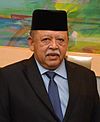 |
Tuanku Syed Sirajuddin | 13 December 2001 – 12 December 2006 | 5 years, 0 days | 17 May 1943 | ||
| 13 | 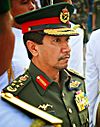 |
Sultan Mizan Zainal Abidin | 13 December 2006 – 12 December 2011 | 5 years, 0 days | 22 January 1962 | ||
| 14 | 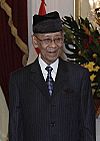 |
Sultan Abdul Halim Mu’adzam Shah 2nd term |
13 December 2011 – 12 December 2016 | 5 years, 0 days | 28 November 1927 | 11 September 2017 (aged 89) | |
| 15 |  |
Sultan Muhammad V | 13 December 2016 – 6 January 2019 | 2 years, 25 days | 6 October 1969 | ||
| 16 |  |
Al-Sultan Abdullah | 31 January 2019 – 30 January 2024 | 5 years, 0 days | 30 July 1959 | ||
| 17 | 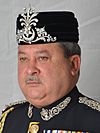 |
Sultan Ibrahim Iskandar | 31 January 2024 – Incumbent | 1 year, 319 days | 22 November 1958 |
Deputy Yang di-Pertuan Agong
The following rulers have served as the Deputy Yang di-Pertuan Agong (Deputy King of Malaysia):
| Name | State | In office | Birth | Death | ||
|---|---|---|---|---|---|---|
| 1 | Sultan Hisamuddin Alam Shah* | 31 August 1957 – 1 April 1960 | 13 May 1898 | 1 September 1960 (aged 62) | ||
| 2 | Tuanku Syed Putra* | 14 April 1960 – 1 September 1960 | 25 November 1920 | 16 April 2000 (aged 79) | ||
| 3 | Sultan Ismail Nasiruddin Shah* | 21 September 1960 – 20 September 1965 | 24 January 1906 | 20 September 1979 (aged 73) | ||
| 4 | Sultan Abdul Halim Mu’adzam Shah* | 1st term | 21 September 1965 – 20 September 1970 | 28 November 1927 | 11 September 2017 (aged 89) | |
| 5 | Sultan Yahya Petra* | 21 September 1970 – 20 September 1975 | 10 December 1917 | 29 March 1979 (aged 61) | ||
| 6 | Sultan Haji Ahmad Shah Al-Musta’in Billah* | 21 September 1975 – 29 March 1979 | 24 October 1930 | 22 May 2019 (aged 88) | ||
| 7 | Tuanku Ja’afar | 1st term | 26 April 1979 – 25 April 1984 | 19 July 1922 | 27 December 2008 (aged 86) | |
| 8 | Sultan Azlan Muhibbuddin Shah* | 26 April 1984 – 25 April 1989 | 19 April 1928 | 28 May 2014 (aged 86) | ||
| 9 | Tuanku Ja’afar* | 2nd term | 26 April 1989 – 25 April 1994 | 19 July 1922 | 27 December 2008 (aged 86) | |
| 10 | Sultan Salahuddin Abdul Aziz Shah* | 26 April 1994 – 25 April 1999 | 8 March 1926 | 21 November 2001 (aged 75) | ||
| 11 | Sultan Mizan Zainal Abidin* | 1st term | 26 April 1999 – 12 December 2001 | 22 January 1962 | ||
| 12 | 2nd term | 13 December 2001 – 12 December 2006 | ||||
| 13 | Sultan Abdul Halim Mu’adzam Shah* | 2nd term | 13 December 2006 – 12 December 2011 | 28 November 1927 | 11 September 2017 (aged 89) | |
| 14 | Sultan Muhammad V* | 13 December 2011 – 12 December 2016 | 6 October 1969 | |||
| 15 | Sultan Nazrin Muizzuddin Shah | 1st term | 13 December 2016 – 31 January 2019 | 27 November 1956 | ||
| 16 | 2nd term | 31 January 2019 – 30 January 2024 | ||||
| 17 | 3rd term | 31 January 2024 – Present | ||||
* Denotes those who became the new Yang di-Pertuan Agong (King) immediately following the end of their tenure as Deputy Yang di-Pertuan Agong (Deputy King).
Timeline of Kings

See also
 In Spanish: Yang di-Pertuan Agong para niños
In Spanish: Yang di-Pertuan Agong para niños


